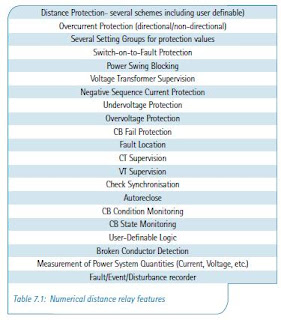


NUMERICAL RELAYS
The distinction between digital and numerical relay rests on points of fine technical detail, and is rarely found in areas other than Protection. They can be viewed as natural developments of digital relays as a result of advances in technology. Typically, they use a specialised digital signal processor (DSP) as the computational hardware, together with the associated software tools.
The input analogue signals are converted into a digital representation and processed according to the appropriate mathematical algorithm. Processing is carried out using a specialised microprocessor that is optimised for signal processing applications, known as a digital signal processor or DSP for short. Digital processing of signals in real time requires a very high power microprocessor. In addition, the continuing reduction in the cost of microprocessors and related digital devices (memory, I/O,
etc.) naturally leads to an approach where a single item of hardware is used to provide a range of functions (‘one-box solution’ approach). By using multiple
microprocessors to provide the necessary computational performance, a large number of functions previously implemented in separate items of hardware can now be
included within a single item. Table 7.1 provides a list of typical functions available, while Table 7.2 summarises the advantages of a modern numerical relay over the static equivalent of only 10-15 years ago. Figure 7.7 shows typical numerical relays, and a circuit board is shown in Figure 7.8. Figure 7.9 provides an illustration of the savings in space possible on a HV feeder showing the space requirement for relays with electromechanical and numerical relay technology to provide the same functionality. Because a numerical relay may implement the
functionality that used to require several discrete relays, the relay functions (overcurrent, earth fault, etc.) are now referred to as being ‘relay elements’, so that a single relay (i.e. an item of hardware housed in a single case) may implement several functions using several relay elements. Each relay element will typically be a software routine or routines.
The argument against putting many features into one piece of hardware centres on the issues of reliability and availability. A failure of a numerical relay may cause
many more functions to be lost, compared to applications where different functions are implemented by separate hardware items. Comparison of reliability and availability between the two methods is complex as interdependency of elements of an application provided by separate relay elements needs to be taken into account.
With the experience gained with static and digital relays, most hardware failure mechanisms are now well understood and suitable precautions taken at the design
stage. Software problems are minimised by rigorous use of software design techniques, extensive prototype testing and the ability to download amended software into memory (possibly using a remote telephone link for download). Practical experience indicates that numerical relays are at least as reliable and have at least as good a record of availability as relays of earlier technologies.
.jpg)
.jpg)